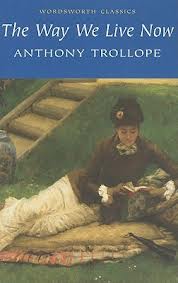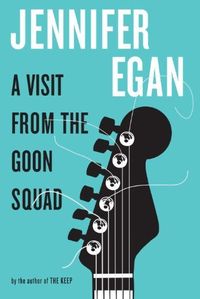 The thing that probably sustained me most as I made my way through Anthony Trollope’s 762-page opus The Way We Live Now was that it really is pretty much about the way we live now, in 2013, even though it was written in 1875. That’s partly because the novel was written in satirical response to financial scandals of the 1870s, and we’ve just lived through a similarly worldwide financial meltdown with some of the same root causes: unchecked greed and irresponsible speculation. Indeed, Trollope wrote that one of his reasons for writing the novel was to expose the way wealth corrupts social values: “Nevertheless a certain class of dishonesty, dishonesty magnificent in its proportions, and climbing into high places, has become at the same time so rampant and so splendid that there seems to be reason for fearing that men and women will be taught to feel that dishonesty, if it can become splendid, will cease to be abominable. If dishonesty can live in a gorgeous palace with pictures on all its walls, and gems in all its cupboards, with marble and ivory in all its corners, and can give Apician dinners, and get into Parliament, and deal in millions, then dishonesty is not disgraceful, and the man dishonest after such a fashion is not a low scoundrel.” He would probably roll over in his grave to see the obeisance paid to Wall Street CEOs who, unlike Trollope’s protagonist Augustus Melmotte, seem to have pulled off their high-class pyramid schemes and escaped with the money.
The thing that probably sustained me most as I made my way through Anthony Trollope’s 762-page opus The Way We Live Now was that it really is pretty much about the way we live now, in 2013, even though it was written in 1875. That’s partly because the novel was written in satirical response to financial scandals of the 1870s, and we’ve just lived through a similarly worldwide financial meltdown with some of the same root causes: unchecked greed and irresponsible speculation. Indeed, Trollope wrote that one of his reasons for writing the novel was to expose the way wealth corrupts social values: “Nevertheless a certain class of dishonesty, dishonesty magnificent in its proportions, and climbing into high places, has become at the same time so rampant and so splendid that there seems to be reason for fearing that men and women will be taught to feel that dishonesty, if it can become splendid, will cease to be abominable. If dishonesty can live in a gorgeous palace with pictures on all its walls, and gems in all its cupboards, with marble and ivory in all its corners, and can give Apician dinners, and get into Parliament, and deal in millions, then dishonesty is not disgraceful, and the man dishonest after such a fashion is not a low scoundrel.” He would probably roll over in his grave to see the obeisance paid to Wall Street CEOs who, unlike Trollope’s protagonist Augustus Melmotte, seem to have pulled off their high-class pyramid schemes and escaped with the money.
Aside from its ruthless mockery of the pretensions of wealth, The Way We Live Now also offers some of the usual insights into the constraints imposed upon women, particularly women of class but no money, and the constant social and economic machinations of a class-obsessed English aristocracy. The action centers around Mr. Melmotte, a banker of shadowy origins (possibly Jewish, of course, about which more later) whose tremendous wealth, which he parlays into social and political power, is revealed to be nothing more than an illusory pyramid scheme. In the meantime, the perception of wealth draws a host of greater and lesser aristocratic characters into his orbit. The sheer length of the novel demands that at least some of these characters pique the reader’s interest, and on this count Trollope doesn’t disappoint. There is the sociopathic Sir Felix Carbury, who seems incapable of any human feeling other than a desire for unlimited funds to continue his dissolute lifestyle of hunting, gambling, and drinking to excess. There is Lady Carbury, his equally sociopathic mother, who impoverishes herself in order to support her wayward son, writing partially plagiarized histories and trashy novels in order to make a few extra pounds that inevitably disappear down the maw of Sir Felix’s endless debt. There are the various Melmotte hangers-on, all of them impoverished gentlemen eager to lend the credibility of their titles to the banker in exchange for the cash windfall they expect to follow. And of course there are a whole host of minor characters with hilarious names: Mr. Squercum, a lawyer, sometime adversary of Mr. Bideawhile, another advocate; Mr. Flatfleece, the shady financier of a local club; Ruby Ruggles and John Crumb, a low-class couple whose romantic difficulties form a large subplot; and my personal favorite, the former Julia Triplex, now elevated by her marriage to Sir Damask Monogram.
 What the novel does not contain is many redeemable characters. Interestingly, however, the one character who seems to have no negative characteristics is one of the many wealthy bankers who populate the novel, Mr. Brehgert. The positive depiction of his character seems unusual not only because he is a banker, and has accumulated great wealth through banking, but also because he is a Jew. We first meet Mr. Brehgert because he proposes marriage to one of the minor characters the plot follows, Georgiana Longstaffe. The daughter of Sir Adolphus Longstaffe, a cash-poor gentleman with business dealings with Mr. Melmotte, Georgey is a bit of a snob who has managed to grow into her late twenties without accepting any of the marriage proposals she deemed inferior in her youth. Now, however, it has become clear to her that her father can no longer maintain her in the style to which she is accustomed, and she becomes desperate to find a rich husband. Unfortunately, however, she has agreed to stay the “season” in London with the Melmottes, and as a result proper society (including her old friend Lady Julia Monogram) shuns her advances and she finds herself unable to meet any eligible men. Thus, when Mr. Brehgert, a fifty-one-year-old widower with five children, proposes to her, she overlooks his age, ethnicity, and occupation and sees only green. The only problem? Her parents, like basically every other self-respecting family of English aristocrats in the nineteenth century (and beyond), are ardent anti-Semites. This is all handled in the same spirit of wicked fun as the rest of the satire, and we get to read things about Georgiana’s mother like, “[she] did not go down into the hall to meet her child – from whom she had that morning received the dreadful tidings about the Jew” or “when her daughter should have married a Jew, she didn’t think that she could pluck up the courage to look even her neighbours…in the face.” Since Trollope has already made some relentless fun of said neighbors, we know how much that’s worth.
What the novel does not contain is many redeemable characters. Interestingly, however, the one character who seems to have no negative characteristics is one of the many wealthy bankers who populate the novel, Mr. Brehgert. The positive depiction of his character seems unusual not only because he is a banker, and has accumulated great wealth through banking, but also because he is a Jew. We first meet Mr. Brehgert because he proposes marriage to one of the minor characters the plot follows, Georgiana Longstaffe. The daughter of Sir Adolphus Longstaffe, a cash-poor gentleman with business dealings with Mr. Melmotte, Georgey is a bit of a snob who has managed to grow into her late twenties without accepting any of the marriage proposals she deemed inferior in her youth. Now, however, it has become clear to her that her father can no longer maintain her in the style to which she is accustomed, and she becomes desperate to find a rich husband. Unfortunately, however, she has agreed to stay the “season” in London with the Melmottes, and as a result proper society (including her old friend Lady Julia Monogram) shuns her advances and she finds herself unable to meet any eligible men. Thus, when Mr. Brehgert, a fifty-one-year-old widower with five children, proposes to her, she overlooks his age, ethnicity, and occupation and sees only green. The only problem? Her parents, like basically every other self-respecting family of English aristocrats in the nineteenth century (and beyond), are ardent anti-Semites. This is all handled in the same spirit of wicked fun as the rest of the satire, and we get to read things about Georgiana’s mother like, “[she] did not go down into the hall to meet her child – from whom she had that morning received the dreadful tidings about the Jew” or “when her daughter should have married a Jew, she didn’t think that she could pluck up the courage to look even her neighbours…in the face.” Since Trollope has already made some relentless fun of said neighbors, we know how much that’s worth.
Aside from the delightful skewering of casual aristocratic prejudices, though, Mr. Brehgert does have an important place in the novel, as he seems to be its moral center. This, of course, is in deliberate contrast to stereotypes of the greedy, morally corrupt Jew (think Shylock), and reverses the poles of virtue: here, it is the supposedly Christian gentlemen who are greedy and corrupt. Brehgert, though he is a banker, appears to be an entirely scrupulous one. He has also invested with Melmotte, but when he learns that Melmotte is a sham he takes his loss without complaint, and refuses to be party to any of Melmotte’s obviously criminal activities. He also proves himself more gentlemanly than the gentlemen in his dealings with his intended fiancée. After Georgiana’s father visits him in London to break off his daughter’s engagement, Brehgert writes Georgiana a long, thoughtful, complimentary letter in which he addresses the complaints against him (including the fact of his Jewishness) with grace and dignity and leaves the choice about whether to marry him entirely up to Georgiana. Though not particularly romantic, Brehgert is affectionate and sincere, writing, “I have no doubt you believe me when I say that I entertain a most sincere affection for you; and I beseech you to believe me in saying further that should you become my wife it shall be the study of my life to make you happy.” Considering that no one else much cares whether Georgey is happy or not as long as she is rich, this is a generous offer indeed.
Although afforded a rather small role in the scope of the book, in its last quarter Mr. Brehgert emerges clearly as the closest thing to a hero there is, suggesting that a better future – of ethical business dealings, sincerity in personal relationships, and greater egalitarianism – lies not in the traditional center of the aristocracy, but in the emerging margins of a professional class made up of those who have formerly been excluded from English society. This, too, seems like a relevant notion at a moment in which the demographics of American culture are shifting and those who were once marginal – immigrants, gay men and lesbians, women, the poor – now lead the way on the path of civil rights and greater economic equality.


